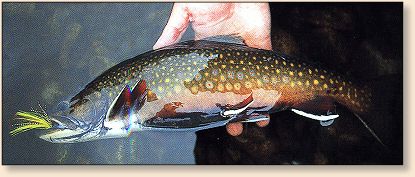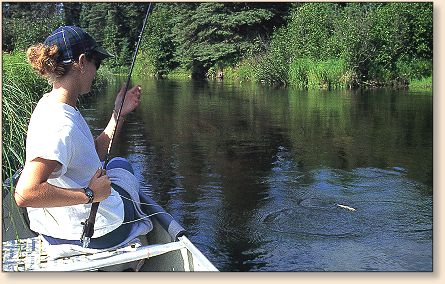North of Superior

By Scott E. Smith
This is where I learned to fly fish; my roots
and desires for this wonderful sport were born
among the spirited wilderness streams of this
region, known affectionately as North of Superior.
Over and above the many pristine nursery tributaries
of Superior that line its entire shore from Thunderbay
to Sault Ste. Mare, are many inland lakes and streams
that are teaming with resident brook trout.
Happily, virtually every waterway that ultimately
terminates in Superior is home to brook trout; the
heritage "trout" species of this wilderness area of
Ontario. Most creeks, streams and rivers are either
presently inhabited by brookies or were at one time
or another. Brook trout (actually a char Salvelinus
fontinalis) are a species of cold, clean water. In
many ways they are an environmental indicator of sorts:
The aquatic version of the cole miner's canary, their
absence in former ranges is indicative of a decline
in water conditions. Conditions that may have
degenerated due to toxic effluent or, more simply,
careless logging practices that have increased sediment
levels - making successful spawning impossible.
Fortunately many streams are still relatively
unspoiled by such atrocities and still abound
with brook trout.
In contrast to the relatively infertile nursery
streams of Superior's coast, there are many smaller
creeks and streams within the headwater systems of
large rivers, such as the Black Sturgeon, the Nipigon
and the Goulais, that are prolific mesotrophic or
eutrophic waters, capable of sustaining substantial
populations of fish. In fact, there are a number
of true spring creeks in this region.
Shillabeer Creek
Shillabeer Creek is one of those true spring creeks.
Water-quality studies of this placid meandering creek
are comparable to the mineral make-up of famous
Western spring creeks, such as Nelson's and
Armstrong's spring creeks. The Shillabeer is a
tributary of the Black Sturgeon River, which
ultimately empties into Black Bay on Superior,
about 80 kilometers east of Thunder Day. The
Shillabeer's origin is a series of groundwater
springs near Shillabeer Lake and Fog Lake, which
converge into a lowland creek that averages thirty
feet in width and five or six feet in depth. The
thick weed growth in the creek appears like giant
moss outcroppings that often brush the bottom of
your canoe as you paddle along and fish the deep,
sandy bend pools and weedbed channels. The creek's
only inhabitants are native brook trout. No migratory
species reach the Shillabeer due to dams on the Black
Sturgeon. The brookies of the Shillabeer are prolific
in numbers with most of the catch - which typically
is twenty or more fish per angler a day - around the
ten-inch mark. However, there are several large fish
to be had in the twelve- to sixteen-inch category.
Some of my friends talk of three- and four-pound fish
from this creek in past years, and although I cannot
personally attest to such glory, I have seen fish take
flies off the water in turbulent splashes that I thought
only beavers made.
 This is a prime example of a stream that has benefited
[ibid] from slot limits, and would most definitely make
the trophy-hunt list if special regulations were placed
on it.
This is a prime example of a stream that has benefited
[ibid] from slot limits, and would most definitely make
the trophy-hunt list if special regulations were placed
on it.
. . .The Shillabeer is most definitely a "Muddler River".
Indeed the best way to fish this sweet little creek is
with a Muddler Minnow. To be more precise, a small size
10 or 8 Muddler fished from a canoe on a four-weight
with a short durable leader of about six feet lone.
Short leaders are the ticket for rapidly punching out
repetitive casts to small pockets and undercut banks
with little back-cast room. My good friend (and local
brook trout guru), Bruce Miller, and I fish the creek
in turn. One paddles while the other sits in the bow
and fires a Muddler to within inches of the bank and
then begins a pulsating retrieve. The length of the
cast is adjusted so this action can be done by twitching
the rod up and back alone, without stripping - which
ultimately leads to lost time and tangles. Obviously
you must fish water before the canoe traverses, and a
good navigator at the stern will keep the canoe on the
shallow side of the numerous bends on the Shillabeer.
Any stick, log or chunk of week on the bottom will most
a brookie or two. Sometimes surprisingly big brookies
will appear from the smallest of cover. Big brookies
in such environs are wily. You must pull the trigger
quick on the take, keep your line tight and tip high
to hold the brookie out of the tangles. You will never
get a second chance on the same day with the same fish
if they are big. At least according to Bruce. ~ Scott E. Smith
Credits: From Ontario, Blue-Ribbon Fly Fishing Guide, published by Frank Amato Publications. We appreciate use permission.
Our Man In Canada Archives
|

